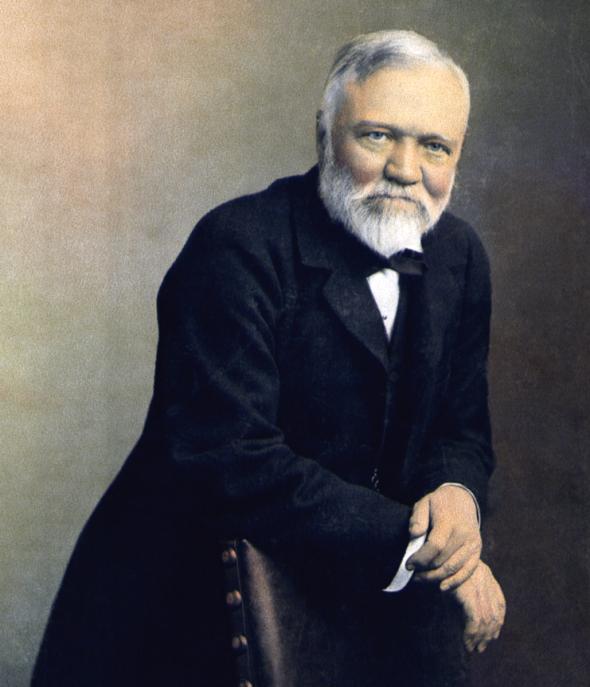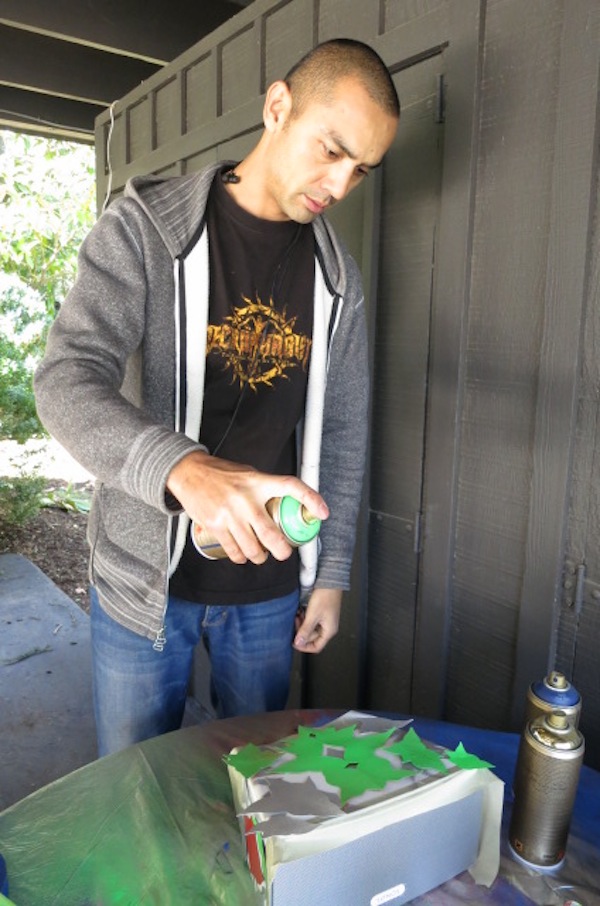How to Rise in the World: Advice on Hustling from Andrew Carnegie:

Last month we explored the
personal finance wisdom that can be gleaned from the life of Benjamin Franklin. Today we will uncover success lessons from a man who has much in common with his colonial counterpart: Andrew Carnegie.
Like Franklin, Carnegie was a self-made man who rose from humble beginnings to international eminence. Carnegie was born in Scotland in 1835 to a failed linen weaver and immigrated to the United States as a boy. With only a year or two of schooling, he moved from factory bobbin boy to railroad executive to iron and steel magnate, eventually becoming the richest man in the world.
Carnegie and Franklin both credited much of their success to self-education (both spent all their spare moments reading any books they could get their hands on) and their membership in mutual improvement groups. As a teenager, Carnegie started a debating club with five of his friends, and the boys traded hour-long speeches on topics such as, “Should the judiciary be elected by the people?” Carnegie would join other literary and social-minded mutual improvement societies throughout his life, and later said: “I know of no better mode of benefiting a youth than joining such a club as this. Much of my reading became such as had a bearing on forthcoming debates and that gave clearness and fixity to my ideas.”
Carnegie was also like Franklin in that he saw the amassing of wealth merely as a means to an end, an end the men shared—retiring early, becoming a man of culture and letters, writing, doing public service, and being an active citizen. Carnegie was not only a “captain of industry,” but a husband and father, an abolitionist and peace activist, a writer and world traveler. And he was one of the greatest philanthropists of all time. He determined early in his career to give away all of his wealth to benefit society, and followed through on his determination, donating close to $400 million (something like $5 billion in today’s dollars) for the building of libraries (3,000 in all), music halls, museums, universities, and pensions for former employees.
Of course Carnegie is a more controversial figure than old Ben. His wealth came from hustling, shrewd decisions, and keen foresight to be sure, but it was also made possible by insider trading and sweetheart deals. (Although it should be noted that such practices were not considered illegal or immoral at the time.) And his rhetoric about respect for labor never aligned with how he actually treated his workers.
But while his later days as a corporate titan may be checkered, the way in which he was able to maneuver himself into a position to even begin climbing the ladder of success bears clear and straightforward lessons that can apply to men in any situation or age.
Note: All quotes, unless otherwise noted, are from the Autobiography of Andrew Carnegie.

Andrew Carnegie, age 16, along with his brother, Thomas
Always Be on the Lookout for Opportunities, and When One Arises, Grab It
Carnegie took his first job at age 13, working 12 hours a day, 6 days a week and earning 20 cents a day as a bobbin boy in a cotton mill. He then moved over to working for another manufacturer, this time tending a boiler in the cellar and running a small steam engine—a job that proved highly stressful as he had to create enough steam for the workers above him, but not so much that the engine would burst.
He didn’t tell his parents about his anxiety though, choosing to “play the man and bear mine burdens.” Instead, he remained optimistic and kept his eyes open for a chance to move ahead:
“My hopes were high, and I looked every day for some change to take place. What it was to be I knew not, but that it would come I felt certain if I kept on. One day the chance came.”
Carnegie’s boss had to make out some bills, and since he didn’t have a clerk, he asked Andrew to do it. He performed the task well, and his appreciative employer kept finding Carnegie odd jobs to keep him from having to work on the steam engine.
To Carnegie this was just the first step in his pursuit of better prospects, and he took it upon himself to prepare for the next opportunity that might open up:
“Mr. Harris kept his books in single entry, and I was able to handle them for him; but hearing that all great firms kept their books in double entry, and after talking over the matter with my companions…we all determined to attend night school during the winter and learn the larger system. So the four of us went to a Mr. Williams in Pittsburgh and learned double-entry bookkeeping.”
In time Carnegie managed to get an interview to work as a messenger boy in a telegraph office—a great step up from his current position—and he did all he could to seize the opportunity:
“The interview was successful. I took care to explain that I did not know Pittsburgh, that perhaps I would not do, would not be strong enough; but all I wanted was a trial. He asked me how soon I could come, and I said that I could stay now if wanted. And, looking back over the circumstance, I think that answer might well be pondered by young men. It is a great mistake not to seize the opportunity. The position was offered to me; something might occur, some other boy might be sent for. Having got myself in I proposed to stay there if I could…
And that is how in 1850 I got my first real start in life…there was scarcely a minute in which I could not learn something or find out how much there was to learn and how little I knew. I felt that my foot was upon the ladder and that I was bound to climb.”
The Ability to Memorize Is a Powerful Tool
“My good Uncle Lauder justly set great value upon recitation in education…In our little frocks or shirts, our sleeves rolled up…with laths for swords, my cousin and myself were kept constantly reciting Norval and Glenalvon, Roderick Dhu and James Fitz-James to our schoolmates and often to older people…
My power to memorize must have been greatly strengthened by the method of teaching adopted by my uncle. I cannot name a more important means of benefiting young people than encouraging them to commit favorite pieces to memory and recite them often. Anything which pleased me I could learn with a rapidity which surprised partial friends.”
Carnegie’s ability to quickly memorize anything came in handy throughout his life, starting when he first landed the job as the telegraph messenger boy:
“I had only one fear, and that was that I could not learn quickly enough the addresses of the various business houses to which messages had to be delivered. I therefore began to note the signs of these houses up one side of the street and down the other. At nights I exercised my memory by naming in succession the various firms. Before long I could shut my eyes and, beginning at the foot of a business street, call off the names of the firms in proper order along one side to the top of the street, then crossing on the other side go down in regular order to the foot again.
The next step was to know the men themselves, for it gave a messenger a great advantage, and often saved a long journey, if he knew members or employees of firms. He might meet one of these going direct to his office. It was recounted a great triumph among the boys to deliver a message upon the street. And there was the additional satisfaction to the boy himself, that a great man (and most men are great to messengers), stopped upon the street in this way, seldom failed to note the boy and compliment him.”
Carnegie memorized not just addresses and names, but passages and quotes from books of philosophy, poetry, history, and literature and from journals on a wide variety of topics. This allowed him to, as his biographer David Nasaw notes, “enter any room and engage anyone in conversation. College presidents, theologians, philosophers, university professors, industrialists, or politicians.” Later in his life he encouraged young men to not only read material related to their jobs, but very broadly as he had, arguing:
“Nothing will bring promotion—and better still, usefulness and happiness–than culture giving you general knowledge beyond the depths of those whom you may have to deal. Knowledge of the gems of literature at call find a ready and profitable market in the industrial world. They sell high among men of affairs as I found with my small stock of knowledge.”
Exercise Initiative by Taking Appropriate Action in the Absence of Orders
The above heading is part of the creed for the Army NCO’s. And it was a maxim that Andrew Carnegie always followed. He understood that the man who sits and waits to be told what to do in critical situations will never get ahead—that it was better to ask for
forgiveness than
permission.
Taking the initiative was how Carnegie started to work his way from telegraph messenger boy to telegraph operator:
“Having to sweep out the operating-room in the mornings, the boys had an opportunity of practicing upon the telegraph instruments before the operators arrived. This was a new chance. I soon began to play with the key and to talk with the boys who were at the other stations who had like purposes to my own.
Whenever one learns to do anything he has never to wait long for an opportunity of putting his knowledge to use.
One morning I heard the Pittsburgh call given with vigor. It seemed to me I could divine that someone wished greatly to communicate. I ventured to answer, and let the slip run. It was Philadelphia that wanted to send a “death message” to Pittsburgh immediately. Could I take it? I replied that I would try if they would send it slowly. I succeeded in getting the message and ran out with it. I waited anxiously for Mr. Brooks to come in, and told him what I had dared to do. Fortunately, he appreciated it and complimented me, instead of scolding me for my temerity; yet dismissing me with the admonition to be very careful and not to make mistakes. It was not long before I was called sometimes to watch the instrument while the operator wished to be absent, and in this way I learned the art of telegraphy. “
Carnegie not only taught himself the art of telegraphy, he was also one of the first to learn how to take down messages by ear; formerly the telegraph operator looked over the slip of paper as it arrived, interpreted the code, and read it to a copyist who transcribed the message. Being able to take the message down directly was a distinct advantage, and when a position as operator opened up, Carnegie, then just 16 years old, was chosen to fill it. Carnegie made such an impression in his new job that just a year later, Thomas A. Scott, the superintendent of the western division of the Pennsylvania Railroad Company, asked the precocious young man to be his personal telegraph operator.
In this position, Carnegie again found an opportunity of gaining attention and respect by stepping into the breach in the absence of orders.
At the time, absolutely no one but the superintendent was allowed to issue orders to the trains, which ran on a single line of tracks. But one day when Carnegie arrived at work, he found that an accident was delaying numerous trains and traffic had come to a standstill. He looked for Scott but couldn’t find him anywhere. Carnegie felt a pit of fear in his stomach, but went ahead and sent out the orders himself, clearing up the snarl and getting the trains moving again. He nervously waited for Scott to arrive, afraid of how his boss would react. But Scott, just like his former boss in the telegraph office, didn’t reprimand him, and from that day on he pretty much handed over order-giving duty to Carnegie. The tale of Carnegie’s “train-running exploit” made its way throughout the company and all the way up to the president of the Pennsylvania Railroad.
And so it was that at age 24, Andrew Carnegie was made superintendent of the railroad’s Pittsburgh Division.

Carnegie believed that his ability to initiate action in the absence of orders was a key to his success, and throughout his life he advised young men who wished to rise in the world to do likewise:
“The question now is how to rise from the subordinate position we have imagined you in, through the successive grades to the position for which you are, in my opinion, and, I trust, in your own, evidently intended. I can give you the secret. It lies mainly in this. Instead of the question, “What must I do for my employer?” substitute “What can I do?” Faithful and conscientious discharge of the duties assigned you is all very well, but the verdict in such cases generally is that you perform your present duties so well that you had better continue performing them. Now, young gentlemen, this will not do. It will not do for the coming partners. There must be something beyond this….The rising man must do something exceptional, and beyond the range of his special department. HE MUST ATTRACT ATTENTION…
One false axiom you will often hear, which I wish to guard you against: “Obey orders if you break owners.” Don’t you do it. This is no rule for you to follow. Always break orders to save owners. There never was a great character who did not sometimes smash the routine regulations and make new ones for himself. The rule is only suitable for such as have no aspirations, and you have not forgotten that you are destined to be owners and to make orders and break orders. Do not hesitate to do it whenever you are sure the interests of your employer will be thereby promoted and when you are so sure of the result that you are willing to take the responsibility. You will never be a partner unless you know the business of your department far better than the owners possibly can. When called to account for your independent action, show him the result of your genius, and tell him that you knew that it would be so; show him how mistaken the orders were. Boss your boss just as soon as you can; try it on early. There is nothing he will like so well if he is the right kind of boss; if he is not, he is not the man for you to remain with–leave him whenever you can, even at a present sacrifice, and find one capable of discerning genius. Our young partners in the Carnegie firm have won their spurs by showing that we did not know half as well what was wanted as they did. Some of them have acted upon occasion with me as if they owned the firm and I was but some airy New Yorker presuming to advise upon what I knew very little about. Well, they are not interfered with much now. They were the true bosses–the very men we were looking for.”
-From “The Road to Business Success: A Talk to Young Men”
Sources:
Autobiography of Andrew Carnegie (read it online for free!)
Andrew Carnegie by David Nasaw
“The Road to Business Success: A Talk to Young Men” by Andrew Carnegie
Related posts:
- The Art of Manliness Podcast Episode #24: Becoming Teddy Roosevelt with Andrew Vietze
- Money and Career Advice from Benjamin Franklin’s Way to Wealth
- Viewers vs. Doers: The Rise of Spectatoritis
- The Menaissance: The Death of the Metrosexual and the Rise of the Retrosexual
- Are You As Fit As a World War II GI?























 What is the real difference between the blogs that have a huge following and the ones that struggle to get anyone to care about them?
What is the real difference between the blogs that have a huge following and the ones that struggle to get anyone to care about them? Within
Within 







